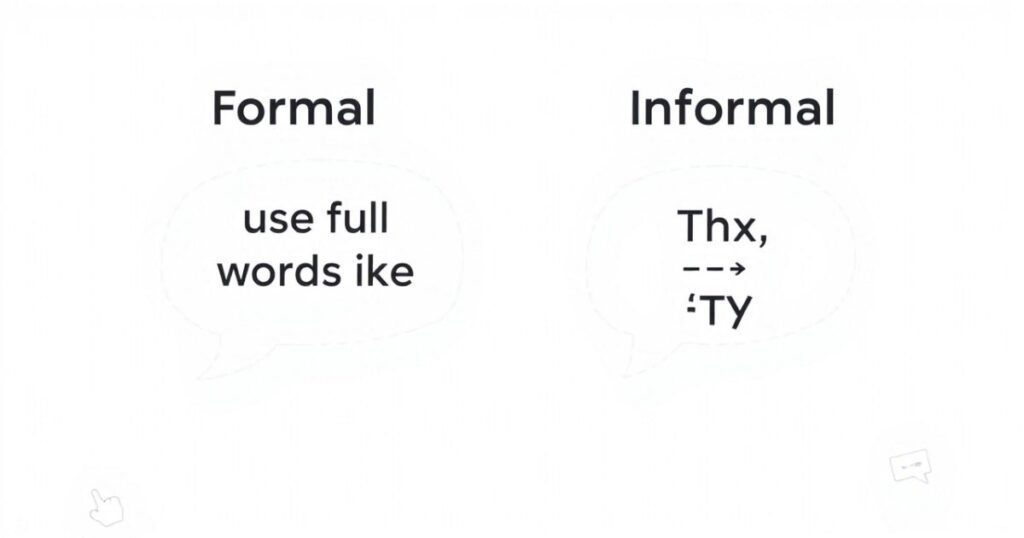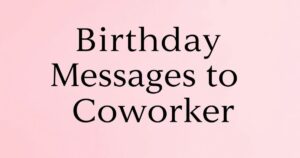Abbreviation for Thanks is common in texting and online chats. People use short forms to save time. The thanks abbreviation makes messages quick and easy. But how do you shorten it? The most popular acronym for thanks is “Thx.” Others include “Tks,” “TY,” and “Tnx.” If you’re wondering, what is the abbreviation for thanks, these are the go-to options. They work well in casual texts, social media, and emails.
Many ask, how to abbreviate thanks in different ways. “Thx” is the most used abbreviation for thanks in digital communication. “TY” is another simple thanks abbreviation often seen in texts. Formal emails still prefer “Thank you,” but short forms are common online. The acronym for thanks helps people communicate fast. Whether in a text or tweet, using a thank you short form makes conversations smooth.
What is the Abbreviation for Thanks?

The abbreviation for thanks is typically “Thx” or “TY.” Both are used in casual communication like text messages, social media, and online chats to quickly express gratitude. These shortened forms save time and are commonly understood in informal settings.
When to Use the Abbreviation for Thanks
Abbreviating “thanks” is common in fast-paced communication. In casual conversations, texts, and online chats, using “Thx” or “TY” saves time. These short forms are great for quick responses, especially on social media, emails, and messaging apps. However, in formal settings, it’s better to write “Thank you” to maintain professionalism.
Context matters when choosing how to express gratitude. If you’re texting a friend, “Thx” feels natural. But in a business email, writing the full phrase shows respect. In workplace communication, abbreviations can seem too informal. Knowing when to use short forms and when to spell out the full word ensures clear and polite communication.
Personal Story: A Quick “Thx” Can Go a Long Way
A simple “Thx” once made my day. I was feeling down when a friend messaged, “Thx for always being there.” It was short, but it meant a lot. That small moment reminded me how powerful gratitude can be. Even in its simplest form, saying thanks can make someone feel appreciated.
We often underestimate the impact of quick gratitude. A short “TY” in a busy chat, a fast “Thanks” in an email, or a casual “Thx” in a text can brighten someone’s mood. Words have power, and even the shortest expressions of appreciation can leave a lasting impression.
What Does Abbreviation for Thanks Mean?
The abbreviation for thanks, such as “Thx” or “TY,” is a shortened way of expressing gratitude, commonly used in text messages, social media, and casual online conversations. It’s a quick, informal way to say “thank you” without taking up too much space or time.
Thanks in Different Contexts:
The way we say “thanks” changes depending on the situation. In casual chats, short forms like “Thx” or “TY” work well. In professional settings, full phrases like “Thank you” are more appropriate. Different cultures also express gratitude in unique ways. While some prefer formal words, others use gestures, bows, or handshakes. Whether spoken, written, or typed, saying thanks strengthens relationships and builds positive connections. Understanding when and how to express gratitude helps maintain good communication.
- Social Media and Texts:
“Thx” is the go-to for quick replies.
Example: “Thx for the follow!” - Professional Emails:
Full phrases sound more respectful.
Example: “Thank you for your time.” - Casual Conversations:
Short and friendly responses work best.
Example: “Thanks a lot!” - Cultural Greetings:
Some cultures use bows or handshakes.
Example: “Arigato” (Japanese for thank you). - Formal Writing:
Complete sentences are preferred.
Example: “I sincerely appreciate your help.” - Customer Service:
Businesses use “thanks” to show appreciation.
Example: “Thank you for your feedback!” - Public Speaking:
Gratitude makes speeches more engaging.
Example: “Thanks for being here today!” - Family and Friends:
Informal thanks feel warm and personal.
Example: “Thanks for always being there!” - Letters and Thank-You Notes:
Handwritten messages leave a lasting impact.
Example: “I appreciate your kindness, thank you!” - Everyday Encounters:
A simple “thanks” brightens someone’s day.
Example: “Thanks for holding the door!”
Definition, Pronunciation, and Examples
An abbreviation for thanks is a shortened version of “Thank you.” It is commonly used in digital communication, where quick responses are necessary. Some of the most popular thanks abbreviation options include “Thx,” “TY,” and “Tks.” These short forms save time and space, making messages more efficient. While “Thank you” is still used in formal writing, abbreviations are perfect for casual conversations, emails, and text messages.
Pronouncing the abbreviation for thanks depends on the form used. “Thx” is often read as “Thanks,” maintaining its original pronunciation. “TY” is spoken as “T-Y,” while “Tks” is sometimes pronounced as “Ticks” or “T-K-S.” Examples of use include “Thx for your help!” in a text or “TY for the update!” in an email. These short forms make digital communication smoother and more convenient. Understanding how to abbreviate thanks is helpful in daily conversations.
The Rise of Abbreviations: How “Thx” Came to Be
The abbreviation for thanks became popular with the rise of digital communication. As people started using emails, text messages, and online chats, they needed a quicker way to express gratitude. Instead of typing out “Thank you,” users began using “Thx,” “TY,” and “Tks.” These short forms made it easier to communicate efficiently. The thanks abbreviation quickly spread across social media, messaging apps, and emails.
The popularity of abbreviations increased with the introduction of character limits on platforms like Twitter and SMS. People wanted to save space while still showing appreciation. Using a thank you short form allowed for fast replies without losing meaning. Today, the acronym for thanks is commonly seen in personal and professional communication. Knowing how to abbreviate thanks helps people engage in quick, effective conversations in a fast-paced digital world.
How to Pronounce Abbreviation for Thanks
Pronouncing the abbreviation for thanks depends on the specific short form used. “Thx” is typically read as “Thanks,” keeping the original pronunciation. “TY” is often spoken as “T-Y,” spelling out the letters separately. “Tks” can be pronounced as “Ticks” or “T-K-S,” depending on personal preference. These variations allow for flexibility in spoken and written communication.
Though the thanks abbreviation is mostly used in writing, some people do say it aloud. In casual conversation, many still prefer to say “Thanks” or “Thank you” instead of the short form. However, in digital spaces like gaming chats and social media, people often use and recognize abbreviations. Using a thank you short form can make interactions quicker, especially in fast-paced conversations where typing out full words is unnecessary.
Short Abbreviation for Thanks
The shortest abbreviation for thanks is “TY.” This two-letter form is widely used in texting, emails, and social media. It provides a quick and clear way to express gratitude. Another short form is “Thx,” which retains the “x” sound while shortening the word. These abbreviations make messaging more efficient, especially in informal conversations.
Many people wonder how to abbreviate thanks in the shortest way possible. “Tks” is another compact version, though it is less common. Each short form has a place in digital communication, depending on the platform and formality level. Whether you’re using thanks abbreviation in a personal text or a quick email, it helps streamline communication. Choosing the right thank you short form depends on the context and audience.
Acronym for Thanks
An acronym for thanks is a shortened way to express gratitude in digital communication. While “Thx” and “TY” are common, they are not true acronyms since they are not formed from the initial letters of multiple words. However, some people consider “TQ” (Thank You) and “TFS” (Thanks for Sharing) as acronyms used online and in messaging.
- Social Media and Texts:
“Thx” is widely used for quick responses, making conversations faster.
Example: “Thx for the shoutout!” - Emails:
“TY” is often used in professional and casual emails to acknowledge someone’s help.
Example: “TY for your prompt response.” - Workplace Communication:
“TQ” is sometimes used in professional chats or memos to show appreciation.
Example: “TQ for your hard work on the project!” - Gaming Chats:
“Thx” is common in online gaming communities to acknowledge support.
Example: “Thx for the backup!” - Customer Support Chats:
Businesses use abbreviations like “TY” to keep responses quick and friendly.
Example: “TY for contacting us. How can we help?” - Text Messages:
People use “Tks” or “Thx” in SMS to keep messages short.
Example: “Tks for the update!” - Online Forums:
Users often write “TYSM” (Thank You So Much) to express deep appreciation.
Example: “TYSM for your advice!” - Twitter Posts:
Due to character limits, “Thx” is preferred for expressing gratitude.
Example: “Thx for all the birthday wishes!” - Streaming Platforms:
Viewers send “TY” in live chats to thank content creators.
Example: “TY for the amazing stream!” - Classroom and Online Learning:
Students and teachers use “TQ” in discussions.
Example: “TQ for explaining that so well!”
Other Examples of Thanks in Context
Gratitude can be expressed in many ways beyond the acronym for thanks. People use different phrases depending on the situation, from casual chats to formal letters. Here are some examples of how people say “thanks” in different contexts.
- Casual Conversations:
Informal phrases like “Much appreciated!” replace “thanks.”
Example: “Much appreciated, buddy!” - Professional Emails:
“I appreciate your time” is a formal way to thank someone.
Example: “I appreciate your time and feedback on this report.” - Text Messaging:
“Tks” is a common shorthand in texting.
Example: “Tks for your help!” - Social Media Comments:
“Thx a lot!” is popular in replies.
Example: “Thx a lot for your support!” - Customer Service:
“We appreciate your business” is often used by companies.
Example: “We appreciate your business and look forward to serving you again.” - Online Shopping Reviews:
“Thanks for the great service!” is commonly seen.
Example: “Thanks for the fast shipping!” - Public Speeches:
“I am grateful to everyone” expresses deep appreciation.
Example: “I am grateful to everyone who made this possible.” - News Interviews:
“Thank you for your time” is a formal way to acknowledge someone.
Example: “Thank you for your time and insights today.” - Podcast and Video Content:
“Shoutout to everyone watching!” thanks the audience.
Example: “Shoutout to everyone watching! Appreciate you all!” - Handwritten Notes:
“Thank you kindly” is a warm way to show appreciation.
Example: “Thank you kindly for your thoughtful gift!”
Related Guide:
Abbreviation for Infrastructure? Definition & Meaning
Synonyms for Thanks
There are many ways to say “thanks” that suit different situations. From formal to casual settings, these alternatives keep communication fresh.
- Business Emails:
“I appreciate it” is a polite alternative.
Example: “I appreciate it. Let me know how I can return the favor.” - Text Messages:
“Much obliged” is a unique phrase used in some regions.
Example: “Much obliged for your quick help!” - Casual Conversations:
“Cheers” is a friendly way to express gratitude.
Example: “Cheers for the ride!” - Online Chatrooms:
“Many thanks” is often used for emphasis.
Example: “Many thanks for your advice!” - Professional Discussions:
“Deeply grateful” shows strong appreciation.
Example: “I am deeply grateful for your mentorship.” - Customer Service:
“We value your support” sounds more formal.
Example: “We value your support and loyalty.” - Letters and Notes:
“With gratitude” is a warm closing.
Example: “With gratitude, I thank you for your kindness.” - Social Media Posts:
“Hats off to you” is a creative way to say thanks.
Example: “Hats off to you for your hard work!” - Public Events:
“Endless gratitude” expresses deep appreciation.
Example: “Endless gratitude to everyone who made this event possible!” - Streaming Platforms:
“Big shoutout” is a fun way to thank people.
Example: “Big shoutout to all my followers!”
Antonym for Thanks
While saying “thanks” shows gratitude, there are words that express the opposite feeling. These words reflect ingratitude, disregard, or lack of appreciation.
- Formal Writing:
“Disregard” means ignoring someone’s help.
Example: “His disregard for kindness upset many people.” - Casual Conversations:
“Indifference” shows a lack of appreciation.
Example: “Her indifference to my effort was disappointing.” - Workplace Communication:
“Unappreciative” describes someone who doesn’t show gratitude.
Example: “His unappreciative attitude affected the team.” - Social Media Debates:
“Ungrateful” is often used in discussions.
Example: “People called him ungrateful for not saying thanks.” - Customer Complaints:
“Rude” describes a lack of politeness.
Example: “The response felt rude and dismissive.” - Emails and Feedback Forms:
“Insensitive” is used when someone ignores efforts.
Example: “His insensitive remark hurt many people.” - Family Conversations:
“Thoughtless” refers to a lack of care.
Example: “Leaving without saying thanks felt thoughtless.” - Online Reviews:
“Disrespectful” means lacking politeness.
Example: “His words seemed disrespectful to the staff.” - News Reports:
“Neglect” means failing to appreciate someone’s help.
Example: “Neglecting gratitude can damage relationships.” - Public Statements:
“Apathetic” means showing no interest.
Example: “He was apathetic about the help he received.”
The Power of Saying “Thanks”
Saying “thanks” may seem simple, but it has a big impact. Expressing gratitude strengthens relationships, boosts morale, and spreads positivity. Whether spoken, written, or sent as a message, a small thank you can brighten someone’s day. It shows appreciation for others’ efforts, making them feel valued and respected. In workplaces, a sincere “thanks” can improve teamwork and productivity. In personal life, it deepens connections and fosters kindness. Even in difficult situations, gratitude helps shift focus to the positive, promoting a healthier mindset.
- Workplace Communication:
A simple “thanks” makes colleagues feel valued.
Example: “Thanks for helping with the report!” - Customer Service:
Businesses use “thank you” to build relationships.
Example: “Thank you for your support!” - Social Media Posts:
Public gratitude strengthens bonds with followers.
Example: “Thanks for the love and support!” - Family and Friends:
Saying “thanks” deepens personal connections.
Example: “Thanks for always being there for me!” - School and Learning:
Teachers appreciate students showing gratitude.
Example: “Thanks for the lesson, it was great!” - Public Speaking:
Gratitude makes speeches more heartfelt.
Example: “Thanks to everyone who made this possible!” - Emails and Texts:
Ending messages with “thanks” leaves a good impression.
Example: “Thanks, looking forward to hearing from you!” - Community and Charity Work:
Acknowledging efforts strengthens unity.
Example: “Thanks to all the volunteers!” - Everyday Interactions:
Simple thanks make daily life better.
Example: “Thanks for holding the door!” - Self-Reflection:
Expressing gratitude increases personal happiness.
Example: “Thanks for today it was amazing!”
When to Use Abbreviations Like “Thx” and “TY”

Abbreviations like “Thx” and “TY” make thanking others quick and easy. They are commonly used in text messages, social media, and casual emails. However, they might not be suitable for professional settings. In formal communication, writing “Thank you” is better. While “Thx” and “TY” work for informal chats, overusing them may come across as impersonal. It’s important to know when to use full words to show genuine appreciation.
- Text Messages:
“Thx” is a quick way to show gratitude.
Example: “Thx for the invite!” - Social Media Comments:
“TY” is used for short, friendly replies.
Example: “TY for the birthday wishes!” - Casual Emails:
“Thanks” is more common, but “TY” is acceptable.
Example: “TY for the update!” - Gaming Chats:
Players use “Thx” to acknowledge teammates.
Example: “Thx for the assist!” - Customer Support Chats:
Quick responses use abbreviations for efficiency.
Example: “TY for reaching out! How can we help?” - Workplace Messaging Apps:
“Thx” may be used in casual work chats.
Example: “Thx for your input on this project!” - Live Streaming & YouTube:
Content creators use “TY” to engage viewers.
Example: “TY for subscribing!” - Event Invitations:
Short responses often use “Thx.”
Example: “Thx, I’ll be there!” - Online Shopping Reviews:
Abbreviations make feedback quicker.
Example: “TY! Great service!” - Everyday Conversations:
Friends and family use “Thx” informally.
Example: “Thx for dinner, it was delicious!”
The History of the Word Abbreviation for Thanks

The abbreviation for thanks has a long history that evolved with language and technology. The word “thanks” comes from Old English “þancas,” meaning gratitude or appreciation. Over time, people shortened “thank you” to simpler forms for faster communication. Before the digital age, people used shorthand writing to save space and time in letters. However, the rise of text messaging and online chats made abbreviations even more popular.
As communication methods changed, so did the need for thanks abbreviation forms. In the early days of the internet, people started using “Thx,” “TY,” and “Tks” in emails and instant messages. These shortened versions allowed for quick responses in both personal and professional settings. Knowing how to abbreviate thanks became essential in a fast-paced digital world. Today, these abbreviations are widely used across social media, texting, and workplace communication.
Examples of the Word and Abbreviations in Context
The word “thanks” and its abbreviations like “Thx” and “TY” appear in various contexts, making communication quicker and more casual. These shortened forms are ideal for informal settings like texts or social media, where brevity is key. Here are some examples of how they’re used in context:
- Text Messages:
“Thx for the quick reply!” - Social Media:
“TY for the support, everyone!” - Emails (Informal):
“Thx for the update, I’ll get back to you.” - Online Chats:
“TY, that helps a lot!” - Group Messages:
“Thx all for the advice!” - Workplace Messaging (Casual):
“Thx for sending the file.” - Twitter (Character Limits):
“Thx for the mention!” - App Notifications:
“TY for checking in today!”
FAQ’s
What is the Abbreviation for Thanks
The most common abbreviation for thank you is “Thx.” Other short forms include “TY,” “Tks,” and “Tnx.” These are often used in texting and emails.
How to abbreviate Abbreviation for Thanks
To shorten “Thank you,” use “Thx” or “TY.” These are quick and easy ways to express gratitude in social media, chats, and messages.
Why use an Abbreviation for Thanks
People use abbreviations to save time. In a fast-paced digital world, short forms like “Thx” and “TY” make communication quicker and more convenient.
Is the Abbreviation for Thanks formal
No, most short forms are informal. While “TY” may work in casual emails, professional settings prefer full phrases like “Thank you” or “Thanks.”
What is the best Abbreviation for Thanks
“Thx” is the most popular choice. However, “TY” and “Tks” are also widely used. The best option depends on the platform and formality level.
Conclusion
Abbreviation for Thanks is useful in texting, emails, and online chats. People often use “Thx,” “TY,” and “Tks” to save time. These short forms make digital communication faster. If you wonder, what is the abbreviation for thanks, the answer depends on the platform. In casual texts, “Thx” and “TY” are common. In emails, some prefer “Tks.” Learning how to abbreviate thanks helps in quick replies. The thanks abbreviation makes conversations smooth and efficient.
Using an acronym for thanks shows appreciation in fewer words. While formal writing needs full phrases, short forms work well in casual messages. Knowing how to abbreviate thanks is useful for texting, social media, and emails. The thank you short form fits perfectly in online conversations. No matter the situation, the abbreviation for thanks helps express gratitude easily. Use the best thanks abbreviation based on the context and audience.

Atlas Reid is an experienced administrator with 5 years of expertise in managing operations, streamlining processes, and ensuring efficiency. Skilled in leadership, organization, and problem-solving to drive business success.








